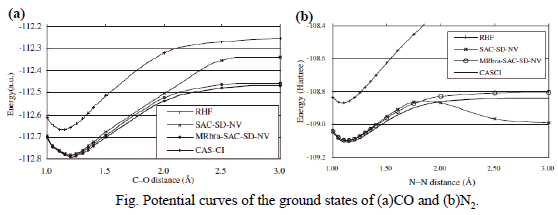
Coupled-Cluster (CC) and CASPT2 methods are sometimes called as "standard" electronic structure methods.
The CC method calculates the dynamical electron correlations.
Including single and double excitations gives accurate results for the molecules in the equillibrium structures.
However, the conventional CC method is no longer accurate in the quasidegenerate electronic structures as bond-breaking and biradical systems.
On the other hand, CASPT2 method is frequently applied to the potential energy surfaces of chemical reactions in the ground and excited states.
However, number of the active orbitals in the CASSCF step limits the target of the CASPT2 applications. Therefore,
the correlated wave function theory for the quasidegenerate systems still need to be cultivated.
The equation for nonvariational SAC-SD (SAC-SD-NV) method has been generalized to have multireference projection space. The results show significant improvements in the description of the potential curves especially in the bond-breaking region. For example, artificial hump seen in the conventional CC method (SAC-SD-NV method) has been disappeared by the present improvement.

The multi-exponentially generated (MEG)/excited (EX)-MEG method[3], which is a multi-reference version of the symmetry-adapted cluster(SAC)/SAC-configuration interaction(CI) method, has been applied to the valence excited and ionized states of ozone that has a quasi-degenerate bi-radical nature in its ground state. The MEG/EX-MEG result shows a remarkable improvement over the single- reference SAC/SAC-CI general-R one in both the correlation energy and the ionization potential. The present results were compared with the previous theoretical and experimental data. The theoretical ionization spectrum reproduced the experimental spectrum observed from outer- to inner-valence regions. This is the first report that gives a theoretical interpretation up to a high-energy region.

[1]Generalization of the Projection Space Improves the SAC-SD (symmetry-adapted cluster - singles and doubles) Method in Bond-Breaking Systems, Jun-ya Hasegawa and Hiroshi Nakatsuji, Chem. Letters. 34, 1356-1357 (2005).
[2]Excited and ionized states of ozone studied by the MEG (multi-exponentially generated) / EX(excited)-MEG method, Y. Ohtsuka, J. Hasegawa, and H. Nakatsuji, Chem. Phys. 332, 262-270 (2007).
[3]Mixed-Exponentially Generated Wave Function Method for Ground, Excited, Ionized, and Electron Attached States of a Molecule, H. Nakatsuji, J. Chem. Phys., 95(6), 4296-4305 (1991)